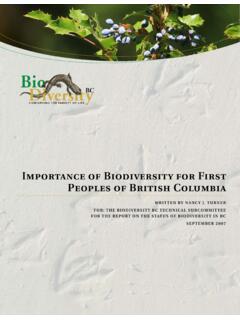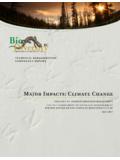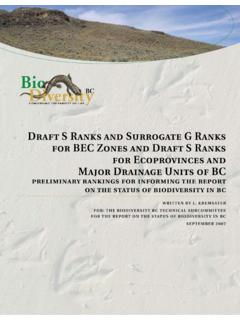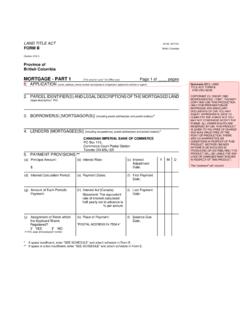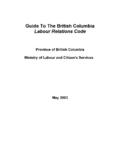Transcription of Major Impacts to Biodiversity in British Columbia
1 Technical subcommitteecomponent reportMajor Impacts to Biodiversityin British Columbia (excluding Climate Change)PREPARED BY: DON GAYTON, FORREXFOR: THE Biodiversity BC TECHNICAL SUBCOMMITTEEFOR THE REPORT ON THE STATUS OF Biodiversity IN BCMAY 2007 Major Impacts TO Biodiversity IN British Columbia (excluding climate change) A REPORT TO THE CONSERVATION PLANNING TOOLS COMMITTEE Prepared by Don Gayton, , FORREX May, 2007 Major Impacts to Biodiversity (Excluding Climate Change). D. Gayton, Forrex. May 2007 iTable of Contents 1 DESCRIBING Impacts ON Biodiversity .. 3 Major Biodiversity Impacts .. 5 Major impact : Urban Sprawl .. 5 Major impact : Aquatic, Terrestrial And Atmospheric Pollution .. 8 Major impact : Fresh Water 10 Major impact : Waterbody Alteration And 12 Major impact : Energy Use .. 13 Major impact : Introduced Invasive 15 Major impact : Forest Harvesting.
2 16 Major impact : Roads, Transmission Lines, Pipelines and Seismic Lines .. 18 Major impact : Mineral, Gravel, Oil, Coal and Gas Extraction .. 19 Major impact : Agriculture .. 20 Major impact : Fire Suppression .. 21 Major impact : Back-Country Recreational Activities .. 22 Major impact : Fishing and Fish Farming .. 23 24 26 Major Impacts to Biodiversity (Excluding Climate Change). D. Gayton, Forrex. May 2007 INTRODUCTION As we rounded the south point of the tiny island, what I thought were lumpy black rocks turned out to be a fine herd of massive California sea lions. The air above us was now thick with glaucous-winged gulls, harlequin ducks, surf scoters, ravens and crows. Gawky double-breasted cormorants festooned the rocks, and bonded pairs of oystercatchers picked delicately along the shoreline. An eagle passed overhead, and as it did so, hundreds of nesting birds swarmed, herding the predator away from their rocky nursery.
3 As we steered our boat in toward a small bay at the north end of the island, we passed a clutch of fat harbour seals. The astounding biological abundance continued as we stepped ashore. Drifts of pink sea-blush, interspersed with yellow monkey flower and blue camas, were strewn artistically across the rocky slopes. In depressions where soil and water accumulate, there were tiger and chocolate lilies, alumroot, saxifrage, brodiaea, Saskatoon and Pacific sanicle. The dry rock basins harboured prickly pear, whose fragile yellow blooms contrasted with their aggressive spines. These notes are from a brief visit to Mitlenatch, an uninhabited islet in the Gulf Islands group, near Campbell River. They describe a mere sampling of the incredible diversity of the islet s lifeforms. To do justice to the flora and fauna of Mitlenatch I would need a few weeks, armed with skin-diving gear, binocular microscope and field glasses. Even then the result would still be a partial catalogue.
4 Mitlenatch is just one example of the biological abundance which our Province contains. British Columbians are becoming aware of that unique richness, and at the same time are realizing their stewardship responsibilities. A key element of stewardship, and a fundamental measure of biological richness and ecosystem health, is a concept called Biodiversity . Biodiversity , and its Impacts , is the subject of this Report. The Report was commissioned by the Conservation Planning Tools Committee1, a consortium of Ministries and ENGO s with a conservation mandate. This Report will become part of the larger Biodiversity Status Report, which will be used as a basis for the development of a Biodiversity Action Plan. It is important to note that climate change Impacts on Biodiversity is addressed in a separate background report, and is not addressed directly in these pages. Biodiversity is not only a challenge to maintain, it is a challenging concept to define.
5 First coined in 1980, we have been in almost daily contact with the word for over twenty-five years. Yet it remains a vague concept for the average person, and even among scientists, there are widely differing interpretations. The working definition of Biodiversity used in this Report is the variety of species and ecosystems and the ecological processes of which they are a part including ecosystem, species and genetic diversity components. The highest conceptual level of Biodiversity is the number of different ecosystems within a given area. Next is the number of species 1 Also known as the Biodiversity BC Steering Committee Major Impacts to Biodiversity (Excluding Climate Change). D. Gayton, Forrex. May 2007 2within a specific ecosystem or site (this level is also known as alpha diversity), and the lowest level of Biodiversity is the amount of genetic diversity within a population of a single species.
6 These three categories or levels are somewhat arbitrary we could just as easily come up with two or twelve but they are useful for describing and managing Biodiversity . The individual levels of Biodiversity are like Russian dolls: one level is nested within the next one above it, and so on. The term Biodiversity itself is not spatially specific; it can be used to describe the biological characteristics of a pond, or of a continent. Biodiversity can also be described not by genes, species and ecosystems, but on the basis of functional types. For example, moose and caribou are separate species, but their ecological function large herbivores is the same. Functional Biodiversity is a less common approach, but has the advantage of focussing on ecological processes herbivory, nitrogen fixation, predation, etc rather than cataloguing genes, species and ecosystems. However, this Report will confine itself to the conventional approach.
7 Although the results are often visually obvious, there is a paucity of quantitative data linking various environmental Impacts to permanent, or even temporary, decreases in Biodiversity . Loss of habitat through land conversion presents a clear, quantifiable case, but linking less dramatic Impacts for example connecting pesticide use or invasive plants to Biodiversity losses is much more challenging. One crude method of monitoring Biodiversity loss is to track fluctuations in the number of species on the Federal and Provincial species at risk lists. However, species additions to the various lists often occur as a result of recent monitoring or research rather than as a result of actual declines in population size or range. So it is not an entirely accurate barometer. Major Impacts to Biodiversity (Excluding Climate Change). D. Gayton, Forrex. May 2007 DESCRIBING Impacts ON Biodiversity In my review of the literature and discussions with Biodiversity practitioners, it became clear that cataloguing the Impacts on Biodiversity in British Columbia could be approached in several different ways.
8 The basis for this difference lies in the concepts of proximate cause (the specific biophysical event that causes the loss of genetic, species or ecosystem diversity) intermediate cause (the human act that triggers the biophysical event) and ultimate cause (the underlying economic, social or policy reason motivating the human act). For example, the proximate cause for the decline in a particular fish population might be excessive siltation of gravel beds where they customarily spawn. The intermediate cause of the decline could be a hydroelectric dam upstream of the spawning bed, which has reduced the volume and velocity of the spring freshet that normally flushes silt out of the gravel. The ultimate cause, in this same instance, is the human demand for electrical energy. Much of our current attention is focussed on proximate and intermediate causes. Impacts on Biodiversity are also a matter of degree. Stepping on an ant is theoretically an impact on Biodiversity , but we deem it to be insignificant.
9 At the other end of the scale, there is general agreement that we have severely damaged the life of the Columbia River with an excessive number of dams on its main stem and tributaries. Somewhere between these two extremes lies the notion of sustainability that ecosystems and biological processes are able to tolerate and absorb certain thresholds of human activity, but above those thresholds, Biodiversity inevitably declines. And finally, social priority and level of knowledge affects our understanding of Biodiversity . As little as two decades ago, British Columbians generally saw the Western Rattlesnake as a dangerous pest, to be killed on sight. Now it is listed as Threatened by COSEWIC, Blue-Listed by the Provincial Government, and the subject of public education programs. This rapid change is symptomatic of a larger shift in social attitudes toward nature, a shift that proceeds apace. If the trend continues, one may assume that previously ignored aspects of our Biodiversity will gain in importance.
10 For instance, insects are a functional part of our biota, yet except for a handful of forest insect pests, we commonly ignore that component when describing and managing ecosystems, mainly because we know so little about them. The cataloguing of British Columbia s insects--including those that are rare and even new to science--proceeds very slowly since only a handful of entomologists are available to work on it. However, it is quite possible that in a few decades insects and other invertebrates will play a Major role in our Biodiversity measures. In the Section that follows, I have made an attempt to identify and document the Major Impacts on Biodiversity in British Columbia (excluding climate change). An initial attempt was made to develop quantitative criteria for selecting Major Impacts , but the Impacts themselves are so diverse and multifaceted, that they almost defy quantitative comparison. In the final analysis, the criteria used for selecting Major Impacts was expert opinion, research, and my own judgment.

